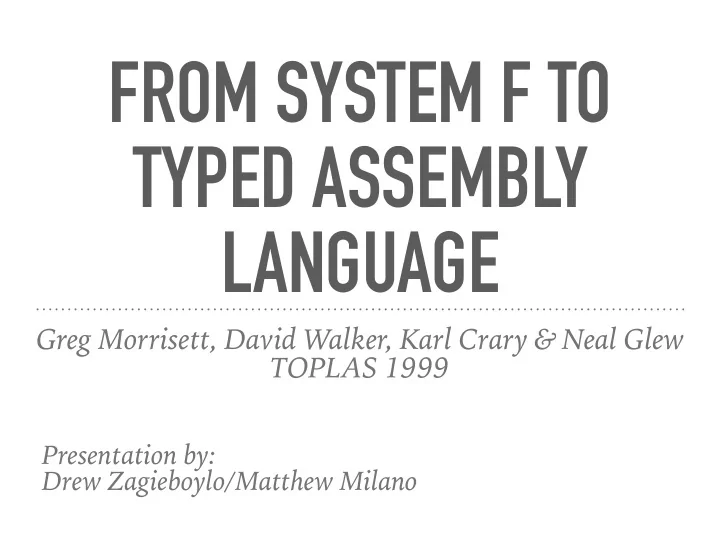

FROM SYSTEM F TO TYPED ASSEMBLY LANGUAGE Greg Morrisett, David Walker, Karl Crary & Neal Glew TOPLAS 1999 Presentation by: Drew Zagieboylo/Matthew Milano
TYPED ASSEMBLY LANGUAGE
TYPED ASSEMBLY LANGUAGE
TYPED ASSEMBLY LANGUAGE
TYPED ASSEMBLY LANGUAGE
WHY DO WE WANT TAL?
TYPE SYSTEMS ALL THE WAY!!
TYPED INTERMEDIATE LANGUAGES ➤ T I L ➤ Throughout the 90’s (and today!) ➤ Benefits of Types (e ffi ciency + soundness) ➤ Target Language is Untyped ML … TIL x86 NO TYPES :( TYPES!
HOW TO GUARANTEE SAFETY W/ UNTYPED AND UNTRUSTED CODE?
PROOF-CARRYING CODE ➤ George Necula (POPL ’97) ➤ Compiler Produces: 1. Program 2. Proof ➤ First-Order Predicate Logic Based ➤ Di ffi cult to Build Compilers
TYPED ASSEMBLY LANGUAGE ➤ Extend benefits of types all the way to the target ➤ Types as implementation of Proof-Carrying Code
TYPED ASSEMBLY LANGUAGE - FEATURES ➤ RISC- style language ➤ Types : ➤ Code types ➤ Pointer Types ➤ Existential Type Constructor ➤ Security: ➤ No pointer forging! ➤ Control Flow Integrity ➤ Other: ➤ Memory Allocation
SYSTEM F TO TAL ➤ Show that TAL is expressive
SYSTEM F TO TAL ➤ CPS Conversion
CPS TRANSLATION ➤ Continuation Passing Style ➤ Translate to near-linear series of let bindings & calls ➤ Removes function call stack Abstraction Translation Application Translation
SYSTEM F TO λ K ➤ Continuation Passing Style ( fix f ( n : int ) : int . if 0 ( n ,1, n × f ( n − 1))) 6 λ F λ K ( fix f ( n : int , k : ( int ) → void ) . if 0( n , k (1), let x = n − 1 in f ( x , λ ( y : int ) . let z = n × y in k ( z )))) (6, λ ( n : int ) . halt [ int ] n )
SYSTEM F TO TAL ➤ Closure Conversion
POLYMORPHIC CLOSURE CONVERSION ➤ Generate Explicit Closures ➤ Implements Encapsulation ➤ New Syntax ➤ Existential Types τ , σ ::= . . . | ∃ α . τ ➤ Packing/Unpacking u ::= . . . | v [ τ ] | pack [ τ 1 , v ] as τ 2 d ::= . . . | [ α , x ] = unpack v ➤ Uses Type Erasure* ➤ Function bodies type-check w/o environment type info ➤ Pack is a no-op at runtime
TO λ C λ K ➤ Polymorphic Closure Conversion Function Type Translation Application Translation
SYSTEM F TO TAL ➤ Hoisting
HOISTING ➤ Separating Code Definition & Program ➤ Much like real memory layout ➤ Closures make this easy! ➤ Bind fix statements to variables, pointing to code
TO λ C λ K ➤ Polymorphic Closure Conversion ➤ Factorial(6)
SYSTEM F TO TAL ➤ Memory Allocation
ALLOCATION ➤ Assembly language doesn’t have Tuples! ➤ Need to allocate memory for tuples (and initialize!) A [[ ⟨ τ 1 , . . . , τ n ⟩ ]] ≜ ⟨ A [[ τ 1 ]] 1 , . . . , A [[ τ n ]] 1 ⟩ ➤ x = (v 1 , v 2 )
ALLOCATION λ H λ A
SYSTEM F TO TAL ➤ Code Generation
SYSTEM F TO TAL ➤ Code Generation ➤ Mostly direct translation to assembly ➤ Function types annotate registers ➤ unpack is just a mov instruction w/ type erasure ➤ malloc is abstract
TAL IMPLEMENTATION ➤ TALx86 : IA32 ISA ➤ Variation from Paper: ➤ Other data types (arrays, floats, etc.) ➤ Not CPS -> Uses Explicit Stack ➤ Implements malloc and unpack instructions ➤ Modules with Type Interfaces ➤ Some optimizations ➤ Register-sized objects vs. “large objects” ➤ Cross-module optimization
CONCLUSIONS ➤ System F -> TAL ➤ We can have security and expressivity ➤ Utilizes many PL techniques ➤ Type-directed Compilation ➤ Formalism omits many optimizations (other work) ➤ Future Work & Impact ➤ Cyclone (low level, typed language) ➤ (and then Rust)
THANK YOU!
POLYMORPHIC CC - TWICE EXAMPLE
POLYMORPHIC CC - TWICE EXAMPLE
Recommend
More recommend